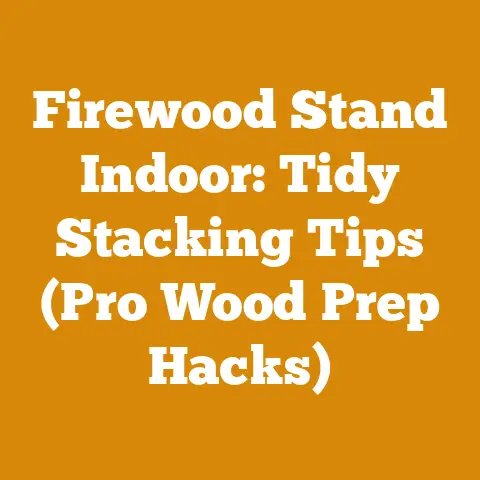Wood Stove Smell Control (5 Expert Tips for Fresh Air)
Alright, let’s talk about wood stove smells.
You know, that delightful aroma of burning wood… or, more accurately, the sometimes-not-so-delightful aroma that can seep into every corner of your house and cling to your clothes like a lovesick lumberjack.
If your living room smells more like a creosote factory than a cozy cabin, you’ve come to the right place.
I’ve spent years wrestling logs, coaxing fires, and perfecting the art of wood-burning, and I’m here to share my hard-earned wisdom on keeping those wood stove smells where they belong: mostly up the chimney.
Here’s my take on how to achieve that fresh air, using tips I’ve learned over countless cords of wood.
Why Does My Wood Stove Smell? Understanding the Culprits
Before diving into solutions, it’s crucial to understand the why.
Several factors contribute to those unwanted wood stove smells.
- Incomplete Combustion: This is the biggest offender.
When wood doesn’t burn completely, it releases gases and particles that haven’t been fully oxidized.
These unburnt byproducts are the source of many unpleasant smells. - Creosote Buildup: Creosote is a tar-like substance that forms when wood smoke condenses in the chimney.
It’s highly flammable and a major fire hazard, but it also smells terrible.
The smell is usually a strong, acrid, and sometimes oily odor. - Draft Issues: A poor draft prevents smoke from escaping up the chimney, causing it to back up into your home.
This can be caused by a blocked chimney, a cold chimney, or negative air pressure in your house. - Damp or Unseasoned Wood: Burning wet or green wood produces more smoke and creosote than dry, seasoned wood.
The water in the wood cools the combustion process, leading to incomplete burning. - Spillage During Loading/Ash Removal: Accidentally spilling ash or dropping pieces of wood while loading the stove can release dust and smells into the air.
- Backdrafting: This occurs when the airflow in your chimney reverses, pulling smoke and fumes back into your home.
It can be caused by a variety of factors, including wind conditions, air pressure imbalances, and obstructions in the chimney.
Key Terms: Demystifying the Wood-Burning Lingo
Let’s get some definitions straight.
This is crucial for understanding the advice I’ll be giving.
- Seasoned Wood: Wood that has been properly dried to a moisture content of 20% or less.
This is the only kind of wood you should be burning. - Green Wood: Freshly cut wood with a high moisture content (often above 50%).
Burning green wood is a recipe for smoke, creosote, and frustration. - Creosote: A flammable tar-like substance that accumulates in chimneys from incomplete combustion of wood.
- Draft: The flow of air through the wood stove and chimney, which draws smoke and gases upwards and out of the house.
- Backdrafting: The reverse of the draft, where air flows down the chimney, bringing smoke and fumes into the house.
- Combustion: The chemical process of burning, where fuel (wood) reacts with oxygen to produce heat and light.
- BTU (British Thermal Unit): A measure of heat energy.
Different types of wood have different BTU ratings. - Cord: A standard unit of measurement for firewood, typically 4 feet high, 4 feet wide, and 8 feet long, totaling 128 cubic feet.
Tip #1: The Wood is Key: Seasoning and Selection
This is the foundation of smell control.
Burning the right wood is half the battle.
The Importance of Seasoned Wood
I can’t stress this enough: use seasoned wood. Burning green wood is like trying to bake a cake with waterlogged flour.
It’s inefficient, smoky, and creates a ton of creosote.
- Moisture Content: Aim for a moisture content of 20% or less.
You can use a moisture meter to check this.
I use a Delmhorst BD-2100, a reliable and durable option.
Cheaper models are available, but accuracy is key. - How to Season Wood:
- Split the Wood: Splitting exposes more surface area, allowing the wood to dry faster.
I usually use a hydraulic log splitter – specifically, a NorthStar 37-Ton Horizontal/Vertical Log Splitter.
It’s overkill for some, but it makes quick work of even the toughest logs.
For smaller jobs, a good splitting axe like a Gransfors Bruks Splitting Axe is a solid choice. - Stack Properly: Stack the wood in a single row, off the ground, with plenty of air circulation.
I prefer stacking on pallets to keep the wood off the damp ground. - Location, Location, Location: Choose a sunny, windy location for your woodpile.
This will maximize drying. - Time is of the Essence: Depending on your climate and the type of wood, seasoning can take anywhere from 6 months to 2 years.
Hardwoods like oak and maple need longer than softwoods like pine.
- Split the Wood: Splitting exposes more surface area, allowing the wood to dry faster.
- Signs of Seasoned Wood:
- Cracks in the end grain
- Lighter weight than green wood
- A dull, grayish color
- A hollow sound when two pieces are struck together
Wood Selection: Not All Wood is Created Equal
Different types of wood burn differently and produce different amounts of smoke and creosote.
- Hardwoods vs.
Softwoods: Hardwoods (oak, maple, ash, birch) are denser than softwoods (pine, fir, spruce) and contain more energy per unit volume.
They burn longer, hotter, and cleaner.
Softwoods tend to burn quickly and produce more smoke and creosote. - Resinous Woods: Avoid burning resinous woods like pine indoors if possible.
The resins contribute to creosote buildup.
If you must burn them, do so in small quantities and make sure your chimney is clean. -
Wood BTU Chart (Approximate):
Wood Type BTU per Cord (Approximate) Oak 24-30 million Maple 20-25 million Ash 20-24 million Birch 20-24 million Beech 22-27 million Cherry 18-22 million Pine 12-18 million Fir 14-20 million Spruce 12-18 million Poplar/Aspen 12-16 million Note: BTU values can vary depending on moisture content and other factors.
My Personal Preference: I primarily burn oak and maple.
They provide a long, consistent burn and minimal smoke when properly seasoned.
I’ll occasionally use birch for kindling, as it lights easily.
Case Study: The Green Wood Disaster
I once made the mistake of burning a load of what I thought was seasoned oak.
Turns out, it was only partially seasoned.
The result?
A smoky, inefficient fire that coated my chimney with creosote.
I had to call in a professional chimney sweep to clean it, costing me several hundred dollars.
Lesson learned: always check the moisture content before burning.
Tip #2: Mastering the Art of Fire Building
How you build and manage your fire has a significant impact on the amount of smoke and creosote produced.
Top-Down vs. Bottom-Up: Which Method is Best?
- Bottom-Up Fire: The traditional method of building a fire, with kindling at the bottom and larger pieces of wood on top.
This method can be smoky, especially in the initial stages. - Top-Down Fire: A more modern approach, with larger pieces of wood at the bottom and kindling and tinder on top.
This method burns cleaner and more efficiently, as the kindling ignites the larger pieces of wood gradually.
This is my preferred method.
Step-by-Step Guide to Building a Top-Down Fire:
- Prepare the Base: Place 3-4 large pieces of seasoned wood at the bottom of the firebox, leaving space for airflow.
- Add Medium-Sized Pieces: Place a layer of medium-sized pieces of wood on top of the base layer, again leaving space for airflow.
- Kindling Layer: Arrange a layer of kindling (small, dry twigs and branches) on top of the medium-sized pieces.
- Tinder: Place a small amount of tinder (easily ignitable material like dry leaves, pine needles, or commercial fire starters) on top of the kindling.
- Light it Up: Light the tinder and let the fire gradually burn downwards.
- Adjust Airflow: Once the fire is established, adjust the air controls to maintain a steady, hot burn.
Optimizing Airflow: The Key to Clean Burning
Airflow is crucial for complete combustion.
Your wood stove has air controls that allow you to regulate the amount of air entering the firebox.
- Starting the Fire: When starting a fire, open the air controls fully to provide plenty of oxygen.
- Maintaining the Burn: Once the fire is established, gradually close the air controls to maintain a steady burn.
Avoid starving the fire of oxygen, as this will lead to incomplete combustion and more smoke. - Reading the Smoke: Observe the smoke coming from your chimney.
Ideally, it should be thin and white or nearly invisible.
Black or gray smoke indicates incomplete combustion. - The “Paper Test”: A simple way to check your draft.
Hold a lit match or lighter near the opening of your wood stove.
If the flame is drawn into the stove, you have a good draft.
If the flame flickers or is blown out of the stove, you have a poor draft.
My Experience: The Airflow Revelation
For years, I struggled with smoky fires.
Then, I learned about the importance of airflow.
I experimented with different air control settings and discovered that a slightly more open setting resulted in a much cleaner burn and less smoke.
It was a game-changer.
Tip #3: Chimney Maintenance: Keeping the Smoke Moving
A clean and well-maintained chimney is essential for proper draft and preventing creosote buildup.
The Importance of Regular Chimney Inspections and Cleaning
- Creosote Buildup: As mentioned earlier, creosote is highly flammable and a major fire hazard.
Regular cleaning removes creosote and reduces the risk of a chimney fire. - Draft Issues: A blocked chimney can restrict airflow and cause smoke to back up into your home.
- Code Requirements: Many local codes require annual chimney inspections and cleaning.
- How Often to Clean: The National Fire Protection Association (NFPA) recommends that chimneys be inspected at least once a year and cleaned as needed.
If you burn wood frequently, you may need to clean your chimney more often.
DIY vs. Professional Chimney Cleaning: Weighing the Options
- DIY Chimney Cleaning: You can clean your chimney yourself using a chimney brush and extension rods.
This can save you money, but it requires some effort and knowledge. - Professional Chimney Cleaning: Hiring a certified chimney sweep is the safest and most thorough option.
They have the tools and expertise to properly inspect and clean your chimney.
Step-by-Step Guide to DIY Chimney Cleaning:
Disclaimer: If you are not comfortable working at heights or are unsure about any aspect of chimney cleaning, it is best to hire a professional.
- Gather Your Supplies: You’ll need a chimney brush (choose the correct size and shape for your chimney), extension rods, a drop cloth, a dust mask, safety glasses, and a vacuum cleaner.
- Prepare the Area: Cover the area around your wood stove with a drop cloth to protect it from soot and debris.
- Access the Chimney: Remove the stovepipe (the section of pipe connecting the wood stove to the chimney) and seal the opening with plastic sheeting and tape to prevent soot from entering your home.
- Brush the Chimney: Starting from the top of the chimney, insert the chimney brush and extension rods and push them down the chimney flue.
Use a twisting motion to scrub the chimney walls. - Repeat as Needed: Repeat the brushing process until you have removed all of the creosote buildup.
- Clean the Firebox: Use a brush and vacuum cleaner to remove any soot and debris from the firebox.
- Reassemble: Reinstall the stovepipe and remove the plastic sheeting.
- Inspect: Carefully inspect the chimney and stovepipe for any signs of damage.
Choosing the Right Chimney Brush: A Crucial Detail
The chimney brush must be the correct size and shape for your chimney flue.
- Round Brushes: For round chimney flues.
- Square Brushes: For square or rectangular chimney flues.
- Wire Brushes: For masonry chimneys.
- Poly Brushes: For metal chimneys.
I use a SootEater Rotary Chimney Cleaning System with flexible rods.
It’s a bit more expensive, but it makes cleaning much easier, especially for chimneys with bends.
Case Study: The Blocked Chimney
A few years ago, I started experiencing a persistent smoky smell in my house.
I initially suspected my wood, but it turned out that a bird had built a nest in my chimney, partially blocking the flue.
After removing the nest, the draft improved dramatically, and the smoky smell disappeared.
This highlights the importance of regular chimney inspections.
Tip #4: Addressing Draft Issues: Getting the Smoke Out
A proper draft is essential for carrying smoke and gases up the chimney and out of your home.
Common Causes of Draft Problems:
- Cold Chimney: A cold chimney can be difficult to start, as the cold air inside resists the upward flow of hot smoke.
- Blocked Chimney: As mentioned earlier, obstructions like bird nests or creosote buildup can restrict airflow.
- Negative Air Pressure: Negative air pressure in your house can counteract the natural draft of the chimney.
This can be caused by exhaust fans, tightly sealed windows and doors, or a poorly designed HVAC system. - Chimney Height: A chimney that is too short may not generate enough draft.
- Nearby Obstructions: Tall trees or buildings near your chimney can disrupt airflow and reduce draft.
Solutions for Improving Draft:
- Warm Up the Chimney: Before starting a fire, try warming up the chimney by burning a small amount of paper or kindling at the base of the chimney flue.
You can also use a heat gun or propane torch to warm the outside of the chimney. - Install a Chimney Cap: A chimney cap prevents rain, snow, and debris from entering the chimney and can also help to improve draft.
- Address Negative Air Pressure:
- Open a window slightly to equalize pressure.
- Turn off exhaust fans when the wood stove is in use.
- Install a fresh air intake near the wood stove.
- Extend the Chimney: If your chimney is too short, you may need to extend it to improve draft.
Consult with a professional chimney sweep or contractor to determine the proper height. - Remove Obstructions: Trim back any trees or shrubs that are blocking airflow near your chimney.
- Install a Chimney Fan: A chimney fan can be installed at the top of the chimney to create a forced draft.
This is a more expensive solution but can be effective in difficult situations.
The Importance of a Chimney Damper
A chimney damper is a metal plate that can be opened or closed to control airflow through the chimney.
- Open Damper: When the wood stove is in use, the damper should be fully open to allow smoke and gases to escape.
- Closed Damper: When the wood stove is not in use, the damper should be closed to prevent heat from escaping up the chimney.
However, note that if you have a gas appliance connected to the same chimney, you typically cannot close the damper completely as this is a safety hazard.
My Experience: The Negative Pressure Nightmare
I once lived in a house with a very tight building envelope and a powerful range hood in the kitchen.
Whenever I used the wood stove and the range hood simultaneously, the negative air pressure would cause the stove to backdraft, filling the house with smoke.
I eventually installed a fresh air intake near the wood stove, which solved the problem.
Tip #5: Proper Wood Stove Operation and Maintenance
Even with the best wood and a clean chimney, improper operation can lead to smoke and smells.
Loading the Wood Stove: Avoiding Spillage
- Load Carefully: Avoid dropping pieces of wood or spilling ash when loading the stove.
- Use a Shovel: Use a small shovel to carefully remove ash from the firebox.
- Empty Ash Regularly: Don’t let ash accumulate in the firebox, as this can reduce airflow and lead to incomplete combustion.
Most stoves need ash removal every 1-3 days during heavy use.
Ash Disposal: A Word of Caution
- Cool Completely: Allow the ash to cool completely before disposing of it.
Hot ash can ignite combustible materials. - Metal Container: Store the ash in a metal container with a tight-fitting lid.
- Safe Location: Place the container on a non-combustible surface away from flammable materials.
- Potential Uses: Wood ash can be used as a soil amendment in gardens, but be sure to research proper application rates.
Regular Cleaning and Maintenance:
- Clean the Glass: Clean the glass door of your wood stove regularly to remove soot and creosote.
You can use a commercial glass cleaner or a mixture of vinegar and water. - Inspect the Gaskets: Inspect the gaskets around the door and stovepipe connections for any signs of damage.
Replace them as needed to ensure a tight seal. - Check for Rust: Inspect the wood stove for any signs of rust.
Clean and paint any rusted areas to prevent further corrosion.
The Importance of a Carbon Monoxide Detector
- Install a CO Detector: Install a carbon monoxide detector near your wood stove to alert you to the presence of this odorless, colorless, and deadly gas.
- Test Regularly: Test the CO detector regularly to ensure that it is functioning properly.
- Replace Batteries: Replace the batteries in the CO detector at least once a year.
Case Study: The Overloaded Stove
I once witnessed a friend overload his wood stove with too much wood.
The fire burned out of control, and the stove overheated.
This resulted in a smoky smell and a potentially dangerous situation.
Always follow the manufacturer’s instructions for loading your wood stove.
Bonus Tip: Air Purifiers
While not a direct solution to the root cause, a good air purifier with a HEPA filter and activated carbon filter can significantly reduce smoke particles and odors in your home.
I use a Blueair Blue Pure 211+ Auto, which is effective at removing smoke, dust, and other allergens.
Strategic Insights: Thinking Beyond the Immediate
These tips are tactical, but let’s zoom out for some strategic considerations:
- Long-Term Wood Supply Planning: Don’t wait until winter to start thinking about your wood supply.
Plan ahead and start seasoning wood well in advance. - Stove Selection: If you’re in the market for a new wood stove, choose a model that is EPA-certified and designed for efficient burning.
- Professional Consultation: Don’t hesitate to consult with a qualified wood stove installer or chimney sweep for advice and assistance.
- Community Knowledge: Talk to experienced wood burners in your area.
They can offer valuable insights and tips specific to your local climate and wood types.
Practical Next Steps: Putting Knowledge into Action
- Assess Your Wood Supply: Check the moisture content of your firewood and start seasoning more wood if needed.
- Inspect Your Chimney: Schedule a chimney inspection or clean it yourself if you are comfortable doing so.
- Evaluate Your Draft: Perform the “paper test” to check your draft and address any issues.
- Refine Your Fire-Building Technique: Experiment with the top-down fire method and optimize your airflow settings.
- Install a CO Detector: If you don’t already have one, install a carbon monoxide detector near your wood stove.
Conclusion
Controlling wood stove smells is an ongoing process that requires attention to detail and a commitment to best practices.
By following these expert tips, you can enjoy the warmth and ambiance of a wood-burning fire without the unwanted odors.
Remember, the key is to burn seasoned wood, maintain a clean chimney, ensure proper draft, operate your stove correctly, and prioritize safety.
With a little effort, you can create a cozy and fresh-smelling home environment all winter long.
Now, go forth and conquer those wood stove smells!






